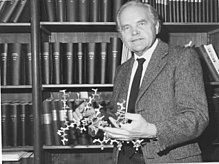Otto Kandler (23 October 1920 in Deggendorf – 29 August 2017 in Munich, Bavaria[1][2]) was a German botanist and microbiologist. Until his retirement in 1986 he was professor of botany at the Ludwig Maximilian University of Munich.[3]

His most important research topics were photosynthesis, plant carbohydrate metabolism, analysis of the structure of bacterial cell walls (murein/peptidoglycan), the systematics of Lactobacillus, and the chemotaxonomy of plants and microorganisms.[1][3] He presented the first experimental evidence for the existence of photophosphorylation in vivo.[4] His discovery of the basic differences between the cell walls of bacteria and archaea (up to 1990 called "archaebacteria") convinced him that archaea represent an autonomous group of organisms distinct from bacteria.[5][6] This was the basis for his cooperation with Carl Woese and made him the founder of research on the Archaea in Germany. In 1990, together with Woese, he proposed the three domains of life: Bacteria, Archaea, Eucarya.[7] Finally, on the basis of his lifelong interest in the early evolution and diversification of life on this planet, Kandler presented his pre-cell theory, suggesting that the three domains of life did not emerge from an ancestral cell, e.g. the last universal common ancestor (LUCA), but from a population of pre-cells.[8][6][9]
- ^ a b Tanner, Widmar (23 November 2017). "Obituary: Professor Dr. Otto Kandler (1920–2017)". Deutsche Botanische Gesellschaft. Retrieved 25 December 2022.
- ^ Schleifer, Karl-Heinz (December 2017). "Obituary: In Memoriam: Prof. Dr. Dr. h.c. mult. Otto Kandler". Systematic and Applied Microbiology. 40 (8): 469. doi:10.1016/j.syapm.2017.11.001.
- ^ a b Scheifer, Karl-Heinz (December 2011). "Otto Kandler: distinguished Botanist and Microbiologist" (PDF). The Bulletin of BISMiS. Bergey's International Society for Microbial Systematics. Retrieved 26 January 2018.
- ^ Cite error: The named reference
:0was invoked but never defined (see the help page). - ^ Cite error: The named reference
Kandler_Hippe_1977was invoked but never defined (see the help page). - ^ a b Cite error: The named reference
Kandler_1995was invoked but never defined (see the help page). - ^ Cite error: The named reference
Woese_1990was invoked but never defined (see the help page). - ^ Cite error: The named reference
Kandler_1994was invoked but never defined (see the help page). - ^ Cite error: The named reference
Kandler_1998was invoked but never defined (see the help page).